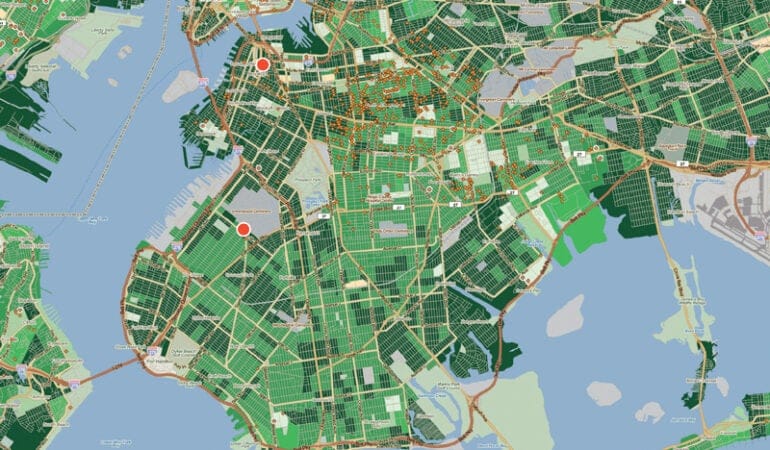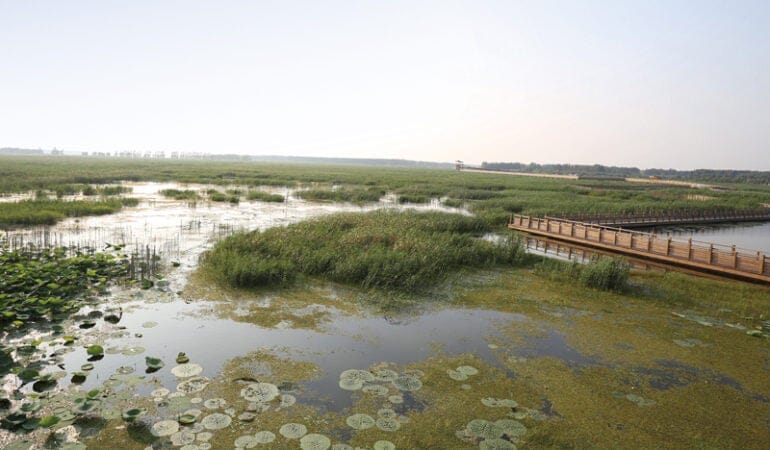Carlos Morales-Schechinger knew he was doomed. An official in Mexico’s ministry for urban development, he was slated to speak at a conference in San Luis Potosi immediately following a fully programmed morning and large lunch. With the students in front of him doing little to fight an onslaught of yawns, Morales had to get creative.
On a whim, he decided to forgo his formal lecture on Mexico’s national urban land policy. Instead, he asked a student in the front of the room if he could buy the chair the student was sitting on, offering a bill from his pocket as payment.
After some initial confusion, the student accepted. Morales then started auctioning off the seat. He spoke in a low voice to illustrate its locational advantage, increasing demand. Soon he had the students invested in both his presentation and that suddenly invaluable piece of furniture. By the end of the session, equipped only with standard classroom objects, he had brought to life the processes of land price determination, densification, and other phenomena related to the notoriously complex and often misrepresented topic of urban land markets.
That was 30 years ago. Over the decades since, Morales’s spontaneous attempt to engage sleepy students has evolved into and informed a variety of educational games, including a multiday organized game called GIROS. Taking its name from the Spanish for both “transaction” and “turning around,” which captures the notion of the interdependencies of land markets, GIROS was designed by Martim Smolka, director of the program on Latin America and the Caribbean at the Lincoln Institute of Land Policy, and enhanced in collaboration with Morales, now a member of the Lincoln Institute’s teaching faculty. GIROS has been played well over 150 times and inspired spinoffs in most of Latin America, and in the Netherlands, Taiwan, Ghana, Kenya, the Philippines, and other countries. Participants have ranged from urban planning students to high-level public officials.
GIROS requires few props. Smolka and Morales developed a basic game board with color-coded pieces used to map the evolution of an imaginary city. Participants divide into teams, wearing hats to indicate roles like government officials, NGOs, different classes of citizens, and developers. During the first rounds, players—assigned “hidden agendas” to simulate the opaque nature of land markets—negotiate and trade plots in a market with little regulation. Halfway through play, the “government” introduces regulations such as high-density zones, altering the city’s development trajectory. When each round concludes or when a theoretically significant phenomenon occurs as the result of a transaction, the students take off their hats to discuss what happened and why.
Depending on the decisions players make, the game can take many forms. But at least two takeaways, evident since the game’s origins, always emerge. The first is that land value is not intrinsic, but is instead shaped by factors including transportation costs, land use regulations, taxation, and other externalities. The second takeaway, which the Lincoln Institute is fully embracing as part of its current instructional design work, is that games are a seriously important part of land policy education.
GIROS is just one of the Lincoln Institute’s growing suite of educational games and interactive tools. While these tools are primarily used in the Institute’s courses in Latin America, active learning increasingly plays a role in all its educational offerings. “In terms of broader learning design, we really want to shift the balance of our in-person courses away from presentations and lectures and toward more active learning activities,” said Ge Vue, associate director of Learning Design at the Lincoln Institute. “The game is one example of this.”
Games are a unique and useful pedagogical tool for a number of reasons, according to Vue. They encourage action, interactivity, and innovative thinking in ways that traditional classroom approaches don’t. Vue emphasizes that games have the potential to teach not just content, but also more applicable problem-solving skills. They are a flexible tool, allowing students to provide feedback and input in real time and facilitators to contribute their own knowledge and guidance along the way.
Giovanni Pérez Macías, a lawyer who first played GIROS in 2007 as part of a three-month Lincoln Institute land policy course in Panama, sees the ability of the instructor to change the direction GIROS takes as one of this game’s strengths. “If Carlos sees that a certain group needs to learn a specific issue in urban development or land policy, he can lead the game [in a way that teaches] that issue,” he says.
Whatever the outcome, Morales explained in a video about the game produced by Erasmus University Rotterdam, students must understand their own influence. “If you win the game, you have to explain why,” he said. “If you aren’t able [to explain why you won], you lose points. The main point is not winning or losing, it is learning.”
Teaching with Games
Popular games that invite players to take on the role of developer or city planner are a familiar part of the cultural landscape. Monopoly was created in 1903 by Henry George aficionado Elizabeth Magie, then bought by the Parker Brothers in the 1930s and transformed into the capitalist game known around the world today. More modern digital games like SimCity, in which players build and manage urban areas, and Minecraft, which places players in an undeveloped landscape with the tools they need to build cities and other structures, have kept the tradition going.
These games overlap with and influence the urban planning world—“I wouldn’t be where I am today without SimCity,” an official with the National Association of City Transportation Officials told the Los Angeles Times for a 30th anniversary article on the game (Roy 2019)—but they don’t always reflect the realities of urban development.
In the case of Monopoly, for instance, Smolka points to the fact that land values don’t vary with the behavior of the players as an example of how the iconic board game reinforces misconceptions about land markets. Smolka explained that part of the inspiration for GIROS came from a game that had been conceived in Bogotá to teach land value capture principles but suffered from this same problem: “You lose the most important part of the conversation. The rationality of the agents must affect land use and land values.”
Smolka is not alone in his assessment. In an article on mainstream citybuilding games, Bradley Bereitschaft, assistant professor of geography at the University of Nebraska, wrote, “the limitations and inaccuracies of these games limit their utility in understanding complex urban processes” (Bereitschaft 2016). In fact, it was that type of academic unease that led to the development of so-called “serious games” beginning in the 1960s. Clark C. Abt, a German educator and engineer, put a name to the emerging trend in his 1970 book Serious Games. Such games, he wrote, “have an explicit and carefully thought-out educational purpose and are not intended to be played primarily for amusement. This does not mean that serious games are not, or should not be, entertaining” (Abt 1970).
Many of the early urban planning games were “products of local needs,” according to Eszter Tóth, a PhD student at HafenCity University Hamberg who conducts research in the field of children’s participation in urban planning (Tóth 2015). Often developed by universities at the behest of local municipalities, these games were typically played only a couple of times and never published. One game that did have a longer shelf life—and has been cited by some as the origin of simulation gaming, which imitates real-life situations—was Metropolis. Richard Duke, a professor at the University of Michigan, designed that simulation in 1966 to help the Lansing City Council work through a complex budgeting process.
Soon after, Alan Feldt, a professor of urban and regional planning at Cornell who would later become one of Duke’s collaborators, designed an urban planning board game specifically intended for use in higher education. The Community Land Use Game (CLUG) centered around a board with 196 one-inch squares. Over the course of 20 hours, five teams made up of two or three students each from his undergraduate and graduate regional planning courses aimed to build factories, stores, and residences in relation to transportation, resources, and utilities with the goal of maximizing land value.
A 1969 Cornell Daily Sun article on Feldt’s game, which by then had been used as a teaching aid in Mexico, Germany, Israel, and England, weighed in on the new trend: “Playing with blocks used to be considered appropriate behavior for kindergarteners, but today’s modern teaching theory is turning such former juvenile pastimes into accepted university techniques.”
Why Play Is Good for Planners
Paulo Sandroni, an economist and now retired professor at the Getulio Vargas Foundation in São Paulo, Brazil, who has collaborated with the Lincoln Institute and developed simulators and games of his own, believes games are particularly useful for teaching urban planners.
“Urban planners in general are decision makers, and a game gives them the opportunity to practice and to play in an arena of trade-offs; if I want more of X, I will have less of Y,” Sandroni said. “Urban planners deal with a whole city, a very complex organism. In other professions there are limitations because they deal with more specific subjects, but games can be adapted to any situation that requires choosing different ways to solve a problem.”
“You can face in real time, even if simplified, the same questions and same problems that the real decision makers do in their professional lives,” Pérez Macías said.
The physical aspect of games like GIROS may be particularly useful for urban planners, who are more physical by nature of their interest in the design of the built environment, said Daphne Kenyon, resident fellow in tax policy at the Lincoln Institute. Kenyon helped facilitate the play of PLUS, a condensed spinoff of GIROS, at the national American Planning Association conference in April 2019. Over the course of the APA session, planners moved between chairs and tables that represented housing units and plots of land. At the conclusion of the first round, when a lack of government intervention had led the players who were in the role of developers to overproduce for the rich and underproduce for the poor, a group of professionally dressed real-life planners huddled together on the floor in an effort to signify their homelessness. Vue explains that students’ physical interaction with a game or the creation of new objects provides more options to represent their thinking and communicate the reasoning behind their actions.
Role-playing games like GIROS also help students inhabit perspectives they might not otherwise, says Kenyon, who plans to use a condensed version of the game in an economics course she teaches at Brandeis University. Kenyon thinks the game might challenge some of her students’ assumptions by forcing them to see the challenges that developers, in particular, can face in city-building scenarios.
The Lincoln Institute’s games are also part of a larger response to a persistent trend: Many urban planning master’s programs, whether in the United States or Latin America, offer limited or no instruction in urban economics and property taxation as part of their core curriculum. Instead, they focus more narrowly on urban design and the physical nature of cities. Smolka and others see games and other active learning techniques as a way to fill this gap. As Smolka explained, “GIROS is designed to teach the kind of professional who is averse to equations or formulas the fundamentals of how land prices are determined and how norms and regulations affect public revenues.”
In the past few decades, as municipalities have increasingly rejected top-down planning processes, serious games have become an increasingly popular tool to aid public processes and help leaders think through real scenarios with real data.
Play the City, an Amsterdam-based firm whose tagline is “serious gaming for smart and social cities,” believes gaming has the potential to replace traditional formats of civic engagement. The company designs physical games tailored to specific cities that bring stakeholders together to address issues including affordable housing, urban expansion, climate change, and participatory design. Play the City is also committed to documenting games that improve city making, and maintains a database that includes GIROS.
The Latin America Context
The Lincoln Institute currently uses GIROS and other games primarily in Latin America, where the majority of the organization’s courses—which focus on formal and informal urban land markets, land value capture, urban redevelopment projects, and other related topics—are offered. While some local governments in the region have embraced the role of games in the planning process, academics have traditionally been less willing to use games in university classrooms.
Sandroni thinks that hesitancy can be attributed to a lack of time, financing, and exposure to these teaching aids. He first started experimenting with using games in his classroom in the 1990s. He noticed that students were always playing cards between classes, so he developed two card games of his own, bringing them into the formal setting of the classroom. Since 1999, he has run O Jogo da Economia Brasileira (Game of the Brazilian Economy), a national tournament in which economics students from across the country compete and gain an understanding of exchange rates, inflation, foreign debt, and other concepts. By supporting teachers and modeling the use of games in the classroom, Sandroni said, “the Lincoln Institute is really pioneering the use of games in education in Latin America.”
Pérez Macías thinks the key to changing the cultural resistance toward games is to provide professional development opportunities so teachers can experience the games for themselves. At least that’s how it worked for him, he said. After taking his first Lincoln Institute course, where he was exposed to most of the Institute’s games that had been developed to date, Pérez Macías started taking additional courses in gamification and became a self-described gamification practitioner, incorporating spinoffs of GIROS into his own courses. He is now using a methodology called LEGO Serious Play that is generally used to facilitate meetings and communication in corporate settings, but which Pérez Macías has adapted as a tool to teach urban issues, like participatory design and negotiation and agreement building between urban stakeholders.
Gislene Pereira, a professor in architecture and urban planning at the Federal University of Paraná who first saw GIROS in 2009 in Caracas, says she appreciated that it allowed participants “to think with the logic of each agent of the city”—literally wearing many hats. She has since helped to oversee the development of a simplified version for use in courses for architecture and urbanism students and in training for city councilors on land policies, tax, and non-tax instruments.
The appetite for games has grown in Latin America, a trend that was confirmed, at least anecdotally, by a weeklong course put on by the Lincoln Institute in Guatemala in early 2019. The course focused on using tools like games and tribunals, crosswords, and videos to teach land market and policy issues to urban planners (see sidebar). As part of the application process, applicants—some of whom had attended Lincoln Institute courses in the past—had to describe a tool they were already using in their classrooms. Of the 78 applications the Institute received, 34 said they used some type of game in their courses, with others citing the use of case studies, simulations, videos, and theater assignments.
“We are seeing much more interest than we thought,” said Enrique Silva, director of International and Institute-Wide Initiatives at the Lincoln Institute. “In Guatemala, we saw that there is an audience and a willingness [for active learning tools], and most importantly a demand. There was a sense that people would love to be more engaged.”
Looking Ahead
The success of GIROS and other games in Latin America has paved the way for the Lincoln Institute to think more strategically and broadly about its pedagogical approach. “We started by thinking that if people acquired knowledge and skills about pressing global challenges and issues and how to address them through land policy, they would make good choices, implement good projects, and make the best use of limited resources to improve the quality of life in the community,” Vue explained. “With games, we’ve become more explicit about critical thinking skills like problem solving, social skills like teamwork and collaboration, and ethical behavior of the different interest groups that are crucial to navigating local and global challenges in the real world.”
Moving forward, Vue hopes to roll out active learning approaches more consistently in the other regions where the Lincoln Institute offers courses and to encourage faculty to rethink the design of conventional courses, lectures, and presentations. The Learning Design program at the Lincoln Institute is embarking on new multimedia projects, including a case study on equitable revitalization in Cleveland that will be used in courses as far afield as Taiwan, and hopes to make many of its tools available on an e-learning platform.
“As the Lincoln Institute thinks about its educational approach, the future may be less about what’s new, and more about how instructors can be most effective at tackling a persistent learning challenge,” Vue said. “The Lincoln Institute operates on a global stage because issues like climate change cross political and geographical boundaries and require change in strategic thinking and ethical behaviors. Through well-designed learning experiences that get people to collaborate, converse, teach, and learn with others who are different from them, people tend to be more humbled about what they don’t know, more open to different perspectives, and more likely to be inspired and feel supported to act globally.” Serious games are one approach, but to reach a diverse audience, Vue explains the Lincoln Institute needs to expand its palette of teaching strategies.
In a sense, he believes the Lincoln Institute’s use of games is an active learning experiment in and of itself. “I am hoping that we can improve the current designs of our games each time we use them,” Vue said. “It doesn’t mean you make a dramatic change in the rules, instead [it’s] around ensuring that a range of participants can learn and succeed. Just because we design a game, doesn’t mean it’s done.”
Active Learning at Lincoln
Ge Vue, associate director of Learning Design at the Lincoln Institute, said he encourages those who teach to think about active learning no matter what tool they’re using: “You can insert instances of active learning in a simple scenario statement in a PowerPoint [just as you might] in a more elaborate, multiday game.” In addition to games such as those described in this article, the Lincoln Institute employs a variety of student-centered, participatory active learning tools, including:
Case Studies
One of the Lincoln Institute’s newer active learning approaches is the use of case studies in the classroom. Over the past year, for example, the Lincoln Institute redesigned a conventional lecture on public-private partnerships into a teaching case study on the financing of Millennium Park in Chicago. The case study, which prompts critical thinking and interaction, was then used in a municipal finance executive education course in collaboration with the University of Chicago Harris School of Public Policy.
Tribunals/Debates
During a Lincoln Institute tribunal session, participants are given a particular proposition, with half of the group required to conduct research and argue in favor, and the other half against. The activity culminates with presentations, questions from other students in the course, and the final verdict of a pre-assigned “judge.”
Theater Productions/Videos
Palo Alto: Un Sistema Economica is a dramatic satire on political economy adapted to the Latin American context. It is based on the 1934 theater production of The Shovelcrats: A Satire on the Illusional Theory of Political Economy by the Schalkenbach Foundation and produced by the Colombia-based Teatro Vreve for use in Lincoln Institute courses. In recent years, teachers have provided students with a version of the script that excludes the final scene, asking students to write an ending.
Cartoons
Produced by the Lincoln Institute and Brazil’s Ministry of Cities, Jose K. Tastro y las Directrices para el Catastro Territorial Multifinalitario represents common situations faced by municipal cadaster employees as they implement land information systems to meet the needs of the public and private sectors. A second cartoon, Jacinto Bené Fício and the Property Tax, tells the story of two cities, one with a well developed property tax system and the other with a poorly developed system.
Crossword Puzzles
The crossword puzzle, un juego de palabras, is used to help students review vocabulary and concepts and offers a less intimidating alternative to drill-based review techniques. The Lincoln Institute’s new crossword puzzle on informal markets asks readers to come up with words based on clues such as “who bears the burden of a charge to land values.”
Emma Zehner is communications and publications editor at the Lincoln Institute.
Photograph: Participants in a Lincoln Institute course in Santa Domingo, Dominican Republic, play a round of GIROS. The teams wear hats to indicate their roles. Credit: Anne Hazel.
References
Abt, Clark C. 1970. Serious Games. New York, NY: Viking Press.
Bereitschaft, Bradley. 2016. “Gods of the City? Reflecting on City Building Games as an Early Introduction to Urban Systems.” Journal of Geography. 115 (2): 51–60. https:// www.tandfonline.com/doi/full/10.1080/00221341.2015.1070366.
Play the City. “Games for Cities Database.” http://gamesforcities.com/database/.
Roy, Jessica. 2019. “From Video Game to Day Job: How ‘SimCity’ Inspired a Generation of City Planners.” Los Angeles Times. March 5. http://gamesforcities.com/database/http://gamesforcities.com/database/.
Tóth, Eszter. 2014. “Potential of Games in the Field of Urban Planning.” In New Perspectives in Game Studies: Proceedings of the Central and Eastern European Game Studies Conference Brno 2014, ed. Tomáš Bártek, Jan Miškov, Jaroslav Švelch, 71–91. Brno, Czech Republic: Masaryk University. https://www.researchgate.net/publication/311233864_Potential_of_Games_in_the_ Field_of_Urban_Planning.


 MW: Resilient Boston Harbor is really a green infrastructure plan. One project that speaks to that is
MW: Resilient Boston Harbor is really a green infrastructure plan. One project that speaks to that is 



